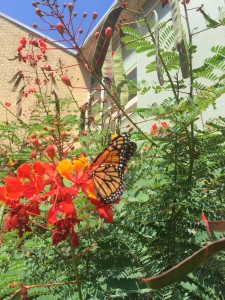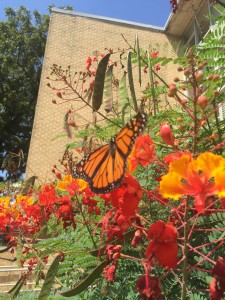I found this monarch, Danaus plexippus, resting on a Caesalpinia pulcherrima plant on campus. Monarchs go through four stages all in one life cycle: egg, larva, pupa, and adult. They go through four generations in one year, which is four different butterflies going through the four stages in one year. Pretty complicated! The monarch that I saw was likely in the fourth generation of the year. This generation is the only one that migrates for the winter. The other three previous generations die off. These migrating monarchs go to places like Southern California or Mexico so the one I saw was probably heading to Mexico to hibernate in oyamel fir trees. Another interesting fact is that even though it is not the same butterfly migrating, they use the same tree when they migrate. Monarchs are also the only butterfly that migrates 2,500 miles away to a warmer climate every year. Then the spring generation flies back to the north. These butterflies migrate because they can’t handle the cold weather and the plants that the larva feed on (they feed solely on milkweed) do not grow in the winter in the north so they migrate also to find food and go back to the north in the spring to find more plentiful plants. Adult monarchs feed on a variety of foods such as nectar, water, and liquids from some of the fruits we consume, such as oranges and watermelon. They tend to mostly consume liquids because of the way they feed. According to worldwildlife.org, the monarch is near threatened right now. Threats to the monarchs include extreme weather causing climate degradation in Mexican forests where the monarchs migrate. Another issue is illegal logging and destruction of forests for agriculture, urbanization, and tourism activities.
My iNaturalist post can be found here.
Sources:
http://www.monarch-butterfly.com/
www.worldwildlife.org/species/monarch-butterfly

